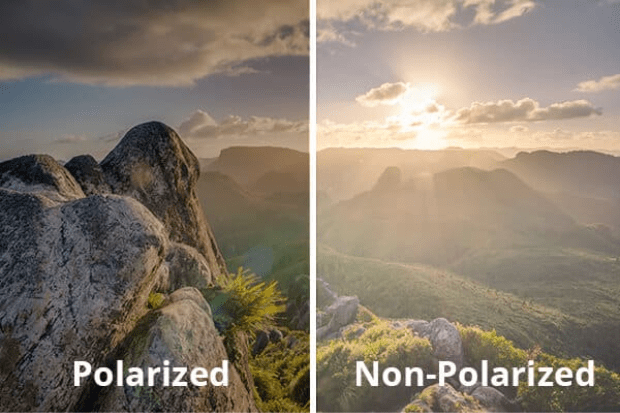Polarized vs non-polarized sunglasses
The main difference between polarized and non-polarized sun lenses is the ability of polarized lenses to absorb incoming polarized light and filter it.
What are Polarized Sunglasses?

View through a Polarized lens
Polarized sunglasses contain a film or a chemical that absorbs and filters incoming polarized light. They are designed to reduce the glare and bright light reflections from reflective surfaces. This includes snow, water, and the road. Polarized sunglasses are great for high-glare situations, such as driving, playing sports, or spending time outdoors.
How Do Polarized Sunglasses Work?
Polarized sunglasses have a special film or a chemical filter that is either inside the lens material or applied as a coating. This absorbs horizontal light and results in reduced glare. Glare is caused by incoming horizontal light, particularly from surfaces such as water or the road. Polarized sunglasses still allow vertical unscattered light to enter the lens, which results in clearer vision.
What Are Non-Polarized Sunglasses?

View through regular tinted lenses
Non-polarized sunglasses have a regular tint added to them. This means that they appear dark, but do not reduce glare like polarized sunglasses do. High-quality non-polarized sunglasses provide the same amount of UV protection, but they are not as comfortable to wear in high-glare situations.
Polarized vs. Non-Polarized Sunglasses

Usages (Who is Each Type of Lens for?)
Polarized sunglasses are best for people who spend a lot of time outdoors or who are sensitive to bright lights. This lens type is especially beneficial if you are in the snow, around water, or are driving.
Non-polarized lenses do not offer the same level of comfort and glare protection. If you are spending short periods of time outdoors and do not have any issues with light sensitivity, then you may opt for non-polarized sunglasses instead.
Benefits
Polarized sunglasses have many benefits over non-polarized sunglasses including:
Better visual comfort
Polarized sunglasses provide much higher levels of glare protection than regular sunglasses. This makes them more comfortable to wear when spending a lot of time outdoors. Wearing polarized sunglasses can also sharpen your vision, by improving your contrast sensitivity and color perception.
Better visibility
As polarized lenses reduce horizontal glare; they provide much more visibility in high-glare situations. These include activities around water or snow, as well as driving. Polarized lenses also allow you to see the road more clearly when it is raining.
Greater prevention of eye strain, headaches, and fatigue
Polarized sunglasses reduce glare and the harshness of bright lights. This prevents feelings of discomfort such as eye strain, headaches, and fatigue. Wearing polarized sunglasses is particularly useful if you are sensitive to bright lights and often find yourself getting headaches after being outdoors for long periods of time.
Many color options
Polarized lenses are available in a variety of colors which can help your vision in different ways. Color options include grey, brown, green, and yellow. Darker lenses (such as grey) typically have a stronger polarizing effect and provide greater glare protection. On the other hand, brown polarized sunglasses make colors appear more vibrant.
Drawbacks
While polarized sunglasses present many advantages, they aren’t for everyone!
The most common issue that people experience with polarized sunglasses is struggling to see digital screens. This is because polarized sunglasses block horizontal light from entering the lens. When using devices such as smartphones, the screen can disappear if your head is positioned on certain angles. This can be fixed by either moving the screen or your head positioning.
Costs
Polarized sunglasses are typically more expensive than non-polarized sunglasses. This is because the manufacturing process is more complicated.
Polarized sunglasses have a special chemical film that is either embedded in the lens or applied as a coating. On the other hand, non-polarized sunglasses are placed in a tint bath to darken the lens.
If you experience any discomfort outdoors or in bright light, then it is worth investing in some polarized sunglasses.
Where Can You Buy Polarized Sunglasses?
At Overnight Glasses, ordering polarized sunglasses is simple! Here’s how you can do it:
- Select a frame – You can sort by brand, color, style, and size. If you have an existing frame that you would like to use, you can select our lens replacement service.
- Enter your glasses prescription – This is also where you will enter your PDs (pupillary distance) and lens type (i.e. single vision, bifocal, or progressive lenses). You can also get polarized sunglasses without a prescription if you don’t need a correction for distance vision.
- Select our outdoors lens package – This is where you can select polarizing, and any additional add-ons that you would like on your glasses.
- Review order and checkout – Here, you can select from our fast delivery options
OvernightGlasses commits to providing high quality glasses in record time. Glasses can be delivered in 24 hours! If you order your glasses before 12pm PST, you will be able to wear them the very next day. Simply select our rush service at checkout.
Polarized and Non-Polarized Sunglasses FAQs
If you spend a lot of time outdoors, or if you are sensitive to bright lights, then polarized sunglasses are definitely worth it!
Polarized sunglasses are more comfortable for your eyes. They prevent symptoms of discomfort such as headaches and eye strain. Polarized sunglasses also provide higher quality vision while outdoors, as they improve the clarity of your vision.
While polarized sunglasses are great for reducing glare and the harshness of light during daytime driving, they are not recommended for driving at night. This is because the darkened lens can make it difficult to see clearly in low-light conditions. If you have difficulty seeing clearly at night, then it can be dangerous to drive while wearing polarized sunglasses.
Usually, high-quality sunglasses have polarized lenses. However, if you aren’t sure about your sunglasses, you can find out by simply holding your sunglasses in front of a screen (such as a computer screen). When you rotate your sunglasses at a 90-degree angle, the lens will become very dark and you will no longer be able to see the screen.
